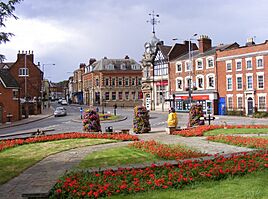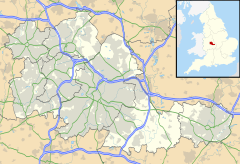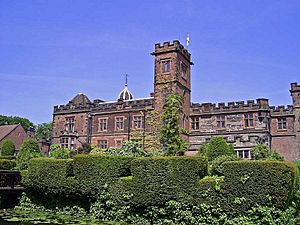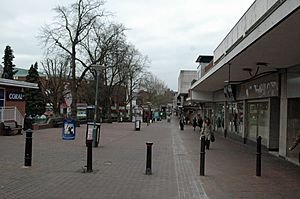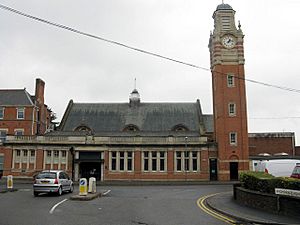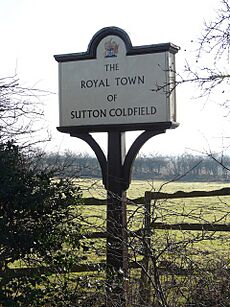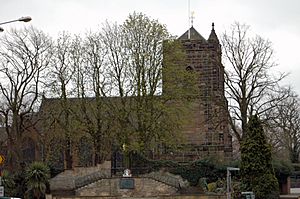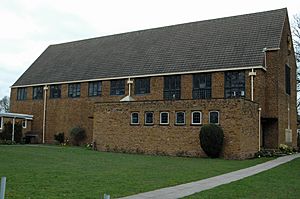Sutton Coldfield facts for kids
Quick facts for kids The Royal Town of Sutton Coldfield |
|
|---|---|
|
Clockwise from top: Sutton Coldfield Church Gardens, Holy Trinity Church, Sutton Park, Town Hall and Parade |
|
| Population | 109,899 (2021 Census) |
| OS grid reference | SP1395 |
| Civil parish |
|
| Metropolitan borough | |
| Metropolitan county | |
| Region | |
| Country | England |
| Sovereign state | United Kingdom |
| Post town | SUTTON COLDFIELD |
| Postcode district | B72 – B76 |
| Dialling code | 0121 |
| Police | West Midlands |
| Fire | West Midlands |
| Ambulance | West Midlands |
| EU Parliament | West Midlands |
| UK Parliament |
|
Sutton Coldfield, also known as the Royal Town of Sutton Coldfield, is a town and civil parish in the city of Birmingham, West Midlands, England. It is located about 8 miles (13 km) northeast of Birmingham city centre.
Sutton Coldfield is part of Birmingham City Council for local government. However, it also has its own town council. This council manages local services and elects a mayor. Historically, Sutton Coldfield was part of Warwickshire. In 1974, it became part of Birmingham and the West Midlands metropolitan county.
Contents
- History
- Governance
- Geography
- Retail and Shopping
- Sport
- Places of Interest
- Public Facilities
- Transport
- Education
- Sutton Coldfield in Literature
- Arts
- Notable Residents
- See also
History
What's in a Name?
The name "Sutton" likely comes from "South Town." This might mean it was a town to the south of Tamworth, which was the capital of Mercia. "Coldfield" describes an area of land on a hillside that is open to the weather. It could also mean a place where people made charcoal by burning wood.
Early Human Life
The first signs of people living in Sutton Coldfield were found between 2001 and 2003. Archaeologists discovered evidence of Bronze Age settlements. They found burnt mounds and a burial mound near Langley Brook. They also found an Iron Age settlement with circular houses.
Near Langley Mill Farm, archaeologists found flint tools from the New Stone Age. This suggests people made tools and lived nearby. In Sutton Park, a fire in 1926 revealed more mounds. These mounds contained charred stones.
Roman Times
The Romans left their mark in Sutton Park. A 1.5-mile (2.4 km) section of Icknield Street runs through the park. This ancient road connected different Roman forts. You can still see the 8-meter (26 ft) wide raised road surface. Romans used compacted gravel to build it. Along the road, Roman coins and pottery have been found.
Archaeologists also found a Roman farmstead near Langley Brook. Pottery from this site dates back to the 2nd and 3rd centuries.
Anglo-Saxon Beginnings
After the Romans left, Sutton Coldfield became part of the Anglo-Saxon kingdom of Mercia. It's believed Sutton Coldfield started as a small settlement around this time. A hunting lodge was built at Maney Hill for Mercian leaders. The outline of their deer park can still be seen in Sutton Park.
The area was known as Sutone. In 1071, it became property of the Crown, ruled by William the Conqueror. This made Sutton Chase a Royal Forest. The Domesday Book of 1086 mentioned Sutone as a large manor.
Growing as a Town
The manor stayed with the Crown until 1135. Then, King Henry I gave it to the Earl of Warwick. It remained with the Earls of Warwick for about 300 years.
In 1300, King Edward I allowed a market to be held every Tuesday in Sutton. He also allowed an annual fair. However, Sutton didn't become a big market town like Birmingham. The market eventually stopped, but new charters were granted later.
The first parish church in Sutton Coldfield was built around 1300. This church later became Holy Trinity Church.
During the 15th century, Sutton Coldfield became a training spot for English soldiers. This was due to Sir Ralph Bracebridge, who leased the manor. Soldiers practiced archery in the town. You can still see marks on a sandstone wall on Coleshill Street where archers sharpened their arrows.
Bishop Vesey's Influence
By the early 1500s, Sutton Coldfield was in decline. The markets were gone, and the manor house was falling apart. But then, John Vesey, who became the Bishop of Exeter, helped revive the town. He was a friend of King Henry VIII.
In 1527, Bishop Vesey built his own home, Moor Hall. He also started a grammar school. On December 16, 1528, King Henry VIII gave Sutton Coldfield a Royal Charter. This created a new local government called the Warden and Society of the Royal Town of Sutton Coldfield. This charter allowed residents to hunt and fish in the manor grounds. It also let them build houses.
King Henry VIII gave his hunting land to the town's residents. This led to the creation of Sutton Park. Bishop Vesey cleared parts of the land for cattle grazing. He also added gates and fences to the park. He paid for the town's streets to be paved, which helped bring back the markets. He also paid for two new aisles at Holy Trinity Church. Bishop Vesey built 51 cottages for the poor. He died in 1555. Today, Sutton Park looks much like it did then. The grammar school he founded is now Bishop Vesey's Grammar School.
Rise of Industry
In the 16th century, the town's pools and waters were used for industry. Mills were built to make blades, gun barrels, and other metal items. By 1597, a blade mill was built at Bracebridge Pool.
The town continued to grow and prosper. However, some pools were drained, though some were later rebuilt.
17th and 18th Centuries
Civil War and Governance
During the English Civil War in 1642, nearby Birmingham was attacked. But Sutton Coldfield remained safe. It's said that King Charles II stayed at New Hall Manor in 1646 while escaping England.
In 1664, King Charles II renewed Sutton Coldfield's royal charter. This allowed for the appointment of two members of the Society to act as justices of the peace.
Industrial Growth
Making blades, gun barrels, and other metal goods became very important to Sutton Coldfield's economy in the 17th century. Mills in Sutton Park and along the Ebrook river powered this industry. Longmoor Pool was created in 1733 for a mill that made buttons. Blackroot Pool was built around 1757 for leather dressing, and later became a sawmill.
Powell's Pool was created in 1730 for a steel-rolling mill. In 1733, a cotton spinning machine was tested here by John Wyatt. This helped start the UK's cotton industry. Sutton Coldfield had 15 watermills in total. There were also two windmills.
A big storm in 1668 caused Wyndley Pool's dam to break. The water flooded downstream, destroying many homes in Sutton Coldfield.
Town Growth and Wealth
Sutton Coldfield grew richer in the 17th and 18th centuries. This led to a better quality of life for its residents. Wealthy people from Birmingham moved to Sutton Coldfield to escape city pollution. In 1630, there were 298 houses, growing to 360 by 1721.
Many important buildings were built or changed during this time. Peddimore Hall was built in 1659. Moat House was built in 1680. The Royal Hotel on High Street dates back to around 1750.
The Commuter Town: 1800s
Town Improvements and New Government
The 1800s brought big changes. The Sutton Coldfield Corporation, the local government, worked to improve the town. They sold timber from felled trees to fund schools and almshouses (homes for the poor).
The old town hall was demolished in 1854. New municipal offices were built in its place. In 1882, Sutton Coldfield became a municipal borough. The old Corporation was replaced by a mayor, aldermen, and elected councillors.
The Arrival of Railways
Before railways, people traveled between Birmingham and Sutton Coldfield by horse carriage. This took about 80 minutes. In 1859, a railway line was approved to connect Birmingham to Sutton Coldfield. It opened on June 2, 1862. The line was later extended to Lichfield in 1884.
A second railway line was proposed, but residents worried it would cut through Sutton Park. Despite objections, construction began. This line opened on July 1, 1879. It had stations at Penns (Walmley), Sutton Coldfield Town, and Sutton Park.
The railways quickly made Sutton Coldfield a popular place for day trips and picnics. People from Birmingham came to escape the city's pollution and enjoy Sutton Park. In 1863, a guide described Sutton Coldfield as a place for "occasional picnic excursion." The Royal Hotel was built in 1865 to welcome tourists.
Sutton Coldfield also became a commuter town. Workers could live away from the city and travel by train to Birmingham. At first, only wealthy people moved here, but later, ordinary workers could too.
Population Growth and Facilities
The first census in 1801 showed Sutton Coldfield had 2,847 people. By 1881, the population had grown to 7,737.
New church parishes were created as the population grew. Walmley became a parish in 1846, followed by Hill in 1853 and Boldmere in 1857. Holy Trinity Church was also expanded.
In 1892, Sutton Coldfield got its first piped water supply. The town's first newspaper, Sutton Coldfield News, started in 1870.
20th Century Changes
Sutton Coldfield continued to grow in the 20th century. After World War I, many houses were built in areas like Boldmere, Walmley, and Four Oaks. During World War II, parts of Sutton Park were used as prisoner-of-war camps.
After the war, the town center was redeveloped. The Parade area was mostly demolished to build a new shopping center called Gracechurch. Other shopping centers were built in Wylde Green and Mere Green.
Joining Birmingham
In 1974, Sutton Coldfield became part of Birmingham when the metropolitan county of the West Midlands was formed.
More recently, the town center has been improved. The Gracechurch Centre was updated, and some areas became pedestrian-only. In 2015, a new Sutton Coldfield parish council was officially formed. This gave the town more local control.
Governance
In 1528, King Henry VIII gave Sutton Coldfield the right to be called "The Royal Town of Sutton Coldfield." It was governed by a warden and a society. This old system lasted until 1885, when it was replaced by a municipal borough. Even though the government changed, people still use the historic "Royal Town" title. This was confirmed in 2014.
Sutton Coldfield was part of Warwickshire until 1974. Then, it joined the City of Birmingham and the metropolitan county of the West Midlands.
Sutton Coldfield has its own parliamentary constituency. The MP for Sutton Coldfield since 2001 has been Andrew Mitchell. Within Birmingham, Sutton Coldfield includes several wards like Sutton Four Oaks and Sutton Trinity.
In 2015, people in Sutton Coldfield voted to have their own Town Council. Almost 70% were in favor. The first election for this new council happened on May 5, 2016.
Geography
Sutton Coldfield includes areas like:
- Boldmere
- Falcon Lodge
- Four Oaks
- Little Aston
- Mere Green
- Minworth
- Walmley
- Wylde Green
Sutton Coldfield borders New Oscott, Erdington, and Streetly. It also borders parts of North Warwickshire, Lichfield, and Tamworth in Staffordshire. Many people see Sutton Coldfield as a very nice place to live in Central England.
The Plants Brook river starts near Streetly and flows through Sutton Park. It goes under the town center and then through Pype Hayes Park before ending at the Plantsbrook Nature Reserve.
Retail and Shopping
The main shopping area in Sutton Coldfield is the Gracechurch Centre. It was built in 1974 and has a multi-storey car park. In 2006, the center was updated with a new glass roof and more shops.
Another shopping center was once called the Sainsbury Centre. After Sainsbury's closed, it became "The Red Rose Centre."
Sutton Parade is a shopping street that is now mostly for pedestrians. New Hall Walk is a row of shops behind The Parade. There are also local shopping areas in suburbs like Wylde Green, Walmley, and Boldmere Road.
Sport
Sutton Coldfield Town F.C. is a football club founded in 1879. They play at Coles Lane. Paget Rangers F.C. also share this ground.
Sutton Coldfield has many golf clubs, including Sutton Coldfield Golf Club and Walmley Golf Club. Nearby is The Belfry, a famous golf complex that has hosted the Ryder Cup.
Several local cricket clubs play in the area, such as Walmley and Sutton Coldfield.
Sutton Coldfield Hockey Club is a field hockey club. Sports facilities, including a swimming pool and 400m athletics track, are at Wyndley Leisure Centre. This center opened in 1971.
In 2022, Sutton Coldfield hosted the Triathlon for the 2022 Commonwealth Games in Sutton Park. The town also has a fencing club.
Places of Interest
Beautiful Parkland
Sutton Park is one of England's largest urban parks, covering 2,224.2 acres (9.0 km²). It's a national nature reserve and a Site of Special Scientific Interest. It's also used for the Great Midlands Fun Run.
New Hall Valley is home to New Hall Valley Country Park, which opened in 2005. It covers 160 acres (0.65 km²) and has New Hall Mill, one of only two working watermills in the West Midlands.
Other nature reserves include Plants Brook Nature Reserve and Hill Hook Nature Reserve.
Historic Houses
Sutton Coldfield has many old and grand houses. Some have been turned into hotels, like the New Hall Hotel and Moor Hall Hotel. Peddimore Hall, a very old hall with a double moat, is still a private home.
Protected Areas
Sutton Coldfield has two conservation areas. The High Street conservation area protects historic buildings on High Street, King Edward's Square, and other nearby streets. It includes Holy Trinity Church and Vesey Memorial Gardens. This area was first protected in 1973.
The Anchorage Road conservation area protects buildings like Moat House. This area was designated in 1992.
Religious Buildings
Holy Trinity Church is one of the oldest churches in town, built around 1300. John Vesey helped expand it, and his tomb is inside.
Other churches include All Saints Church in Four Oaks, built in 1908. St Peter's Church in Mere Green and St Chad's Church near Walmley were also designed by Charles Bateman. St Johns Church in Walmley was built in 1845.
In Wylde Green, The Church of Jesus Christ of Latter-day Saints has a chapel built in the early 1990s. This site will also be home to the Birmingham England Temple, a new temple for the church.
Green Belt Areas
Birmingham has a large "green belt" area, which is protected land. Much of this green belt is in the north of the city, especially around Sutton Coldfield. This land is meant to stop urban sprawl.
However, parts of Sutton Coldfield's green belt are being developed. Over 5,500 houses and a large industrial complex are being built.
Public Facilities
The Town Hall is now used as a theater and event venue.
Sutton Parade is a pedestrian-friendly shopping area. Sutton Coldfield Library, which opened in 1974, is located above the Red Rose Centre. It has a large collection of local newspapers and magazines.
Sutton Coldfield railway station is part of the Birmingham Cross-City Line. Near the station is the entrance to Sutton Park and its Visitor's Centre.
Sutton Coldfield has four Community Centres and several smaller Community Halls. These offer many classes and events.
Good Hope Hospital provides main hospital services, including emergency care. Sutton Cottage Hospital also serves the town.
On Lichfield Road, Sutton Coldfield has a police station and fire station. Sutton Coldfield College is the main college for further education. The Sutton Coldfield transmitting station, the first television transmitter outside London, is also nearby.
Transport

Sutton Coldfield is a commuter town for people working in Birmingham. It has frequent train services from Sutton Coldfield railway station on the Cross-City Line. The Sutton Coldfield rail crash happened here in 1955 when a train went too fast around a curve.
The Sutton Park Line also crosses the town. It used to have passenger services but now only carries freight.
The Roman road Icknield Street goes through Sutton Park. The town is also close to major motorways like the M6 Toll, M6, and M42. The A38 bypasses the town to the east.
The Parade in the town center is a main stop for many National Express West Midlands bus services. These buses connect Sutton Coldfield to Birmingham, Walsall, Lichfield, and Tamworth.
Education
Sutton Coldfield has several secondary schools for ages 11–18. These include Fairfax Academy, The John Willmott School, Sutton Coldfield Grammar School for Girls, Bishop Vesey's Grammar School, The Arthur Terry School, The Plantsbrook School, and Bishop Walsh Catholic School.
There are also many primary schools, such as St Joseph Catholic Primary School, Whitehouse Common Primary School, and Walmley Primary School.
Highclare School is a private primary and secondary school with two sites in Sutton Coldfield. St Nicholas Catholic Primary School is a Catholic primary school established in 1967.
Sutton Coldfield in Literature
Sutton Coldfield is mentioned in William Shakespeare's play Henry IV, Part 1. Falstaff, a character, says he will march his soldiers to Sutton-Co’fil’.
Several modern novels are also set in the town. Pop by Kitty Aldridge is based here in the 1970s. Hekla's Children by James Brogden uses Sutton Park as a key location. The Sadness of The King George by Shaun Hand is set in the town in 2005.
Arts
Sutton Coldfield has a lively arts community. There are many local amateur dramatic groups, musical theater companies, orchestras, and dance schools. The Royal Sutton Coldfield Orchestra started in 1975.
"Made in Sutton" is a local arts group that brings together different arts organizations. The Royal Sutton Coldfield Concert Orchestra also holds regular concerts. There are two major amateur theaters: Highbury Theatre and Sutton Arts Theatre.
The members of the British hip hop group The Northern Boys are from Sutton Coldfield.
Notable Residents
Many famous people were born or have lived in Sutton Coldfield, including:
- Scott Adkins – actor
- Barry Bannan – footballer
- Lucy Benjamin – actress
- Cat Deeley – television presenter
- Rory Delap – footballer
- Doug Ellis – former Aston Villa chairman
- Trevor Eve – actor
- Rob Halford – singer of Judas Priest
- Rasmus Hardiker – actor
- Jonathan Harvey – composer
- Arthur Lowe – comic actor
- Paul Merson – footballer
- Andrew Mitchell – the town's MP
- Sir Roger Moore – actor, famous for playing James Bond
- James and Oliver Phelps – actors, played the Weasley twins in the Harry Potter films
- Abi Phillips – actress
- Bradley Will Simpson – lead singer of The Vamps
- Jane Sixsmith – international hockey player
- Connie Talbot – child singer
- Dennis Waterman – actor
- Emma Willis – television presenter
- Chris Woakes – England cricketer
- Dorian Yates – six-time Mr. Olympia bodybuilding champion
|
See also
 In Spanish: Royal Sutton Coldfield para niños
In Spanish: Royal Sutton Coldfield para niños


